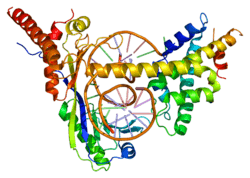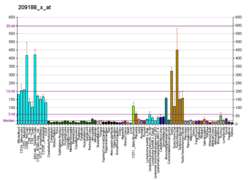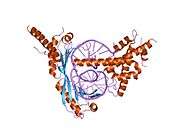DR1 (gene)
Protein Dr1 is a protein that in humans is encoded by the DR1 gene.[5][6][7]
Function
This gene encodes a TBP- (TATA box-binding protein) associated phosphoprotein that represses both basal and activated levels of transcription. The encoded protein is phosphorylated in vivo and this phosphorylation affects its interaction with TBP. This protein contains a histone fold motif at the amino terminus, a TBP-binding domain, and a glutamine- and alanine-rich region. The binding of DR1 repressor complexes to TBP-promoter complexes may establish a mechanism in which an altered DNA conformation, together with the formation of higher order complexes, inhibits the assembly of the preinitiation complex and controls the rate of RNA polymerase II transcription.[7]
Interactions
References
- 1 2 3 GRCh38: Ensembl release 89: ENSG00000117505 - Ensembl, May 2017
- 1 2 3 GRCm38: Ensembl release 89: ENSMUSG00000029265 - Ensembl, May 2017
- ↑ "Human PubMed Reference:".
- ↑ "Mouse PubMed Reference:".
- ↑ Inostroza JA, Mermelstein FH, Ha I, Lane WS, Reinberg D (Sep 1992). "Dr1, a TATA-binding protein-associated phosphoprotein and inhibitor of class II gene transcription". Cell. 70 (3): 477–89. doi:10.1016/0092-8674(92)90172-9. PMID 1339312.
- ↑ Purrello M, Di Pietro C, Rapisarda A, Viola A, Corsaro C, Motta S, Grzeschik KH, Sichel G (1996). "Genomic localization of the human gene encoding Dr1, a negative modulator of transcription of class II and class III genes". Cytogenetics and Cell Genetics. 75 (2–3): 186–9. doi:10.1159/000134479. PMID 9040789.
- 1 2 "Entrez Gene: DR1 down-regulator of transcription 1, TBP-binding (negative cofactor 2)".
- ↑ Yeung K, Kim S, Reinberg D (Jan 1997). "Functional dissection of a human Dr1-DRAP1 repressor complex". Mol. Cell. Biol. 17 (1): 36–45. PMC 231727. PMID 8972183.
- ↑ Mermelstein F, Yeung K, Cao J, Inostroza JA, Erdjument-Bromage H, Eagelson K, Landsman D, Levitt P, Tempst P, Reinberg D (Apr 1996). "Requirement of a corepressor for Dr1-mediated repression of transcription". Genes Dev. 10 (8): 1033–48. doi:10.1101/gad.10.8.1033. PMID 8608938.
Further reading
- Maruyama K, Sugano S (1994). "Oligo-capping: a simple method to replace the cap structure of eukaryotic mRNAs with oligoribonucleotides". Gene. 138 (1–2): 171–4. doi:10.1016/0378-1119(94)90802-8. PMID 8125298.
- Goppelt A, Stelzer G, Lottspeich F, Meisterernst M (1996). "A mechanism for repression of class II gene transcription through specific binding of NC2 to TBP-promoter complexes via heterodimeric histone fold domains". EMBO J. 15 (12): 3105–16. PMC 450253. PMID 8670811.
- Kashanchi F, Khleif SN, Duvall JF, Sadaie MR, Radonovich MF, Cho M, Martin MA, Chen SY, Weinmann R, Brady JN (1996). "Interaction of human immunodeficiency virus type 1 Tat with a unique site of TFIID inhibits negative cofactor Dr1 and stabilizes the TFIID-TFIIA complex". J. Virol. 70 (8): 5503–10. PMC 190508. PMID 8764062.
- Cowell IG, Hurst HC (1996). "Protein-protein interaction between the transcriptional repressor E4BP4 and the TBP-binding protein Dr1". Nucleic Acids Res. 24 (18): 3607–13. doi:10.1093/nar/24.18.3607. PMC 146135. PMID 8836190.
- Rozet JM, Gerber S, Perrault I, Camuzat A, Calvas P, Viegas-Pequignot E, Molina-Gomes D, Le Paslier D, Chumakov I, Munnich A, Kaplan J (1996). "Structure and physical mapping of DR1, a TATA-binding protein-associated phosphoprotein gene, to chromosome 1p22.1 and its exclusion in Stargardt disease (STGD)". Genomics. 36 (3): 554–6. doi:10.1006/geno.1996.0508. PMID 8884286.
- Suzuki Y, Yoshitomo-Nakagawa K, Maruyama K, Suyama A, Sugano S (1997). "Construction and characterization of a full length-enriched and a 5'-end-enriched cDNA library". Gene. 200 (1–2): 149–56. doi:10.1016/S0378-1119(97)00411-3. PMID 9373149.
- Kamada K, Shu F, Chen H, Malik S, Stelzer G, Roeder RG, Meisterernst M, Burley SK (2001). "Crystal structure of negative cofactor 2 recognizing the TBP-DNA transcription complex". Cell. 106 (1): 71–81. doi:10.1016/S0092-8674(01)00417-2. PMID 11461703.
- Gilfillan S, Stelzer G, Piaia E, Hofmann MG, Meisterernst M (2005). "Efficient binding of NC2.TATA-binding protein to DNA in the absence of TATA". J. Biol. Chem. 280 (7): 6222–30. doi:10.1074/jbc.M406343200. PMID 15574413.
- Lewis BA, Sims RJ, Lane WS, Reinberg D (2005). "Functional characterization of core promoter elements: DPE-specific transcription requires the protein kinase CK2 and the PC4 coactivator". Mol. Cell. 18 (4): 471–81. doi:10.1016/j.molcel.2005.04.005. PMID 15893730.
- Rual JF, Venkatesan K, Hao T, Hirozane-Kishikawa T, Dricot A, Li N, Berriz GF, Gibbons FD, Dreze M, Ayivi-Guedehoussou N, Klitgord N, Simon C, Boxem M, Milstein S, Rosenberg J, Goldberg DS, Zhang LV, Wong SL, Franklin G, Li S, Albala JS, Lim J, Fraughton C, Llamosas E, Cevik S, Bex C, Lamesch P, Sikorski RS, Vandenhaute J, Zoghbi HY, Smolyar A, Bosak S, Sequerra R, Doucette-Stamm L, Cusick ME, Hill DE, Roth FP, Vidal M (2005). "Towards a proteome-scale map of the human protein-protein interaction network". Nature. 437 (7062): 1173–8. doi:10.1038/nature04209. PMID 16189514.
- Malecová B, Gross P, Boyer-Guittaut M, Yavuz S, Oelgeschläger T (2007). "The initiator core promoter element antagonizes repression of TATA-directed transcription by negative cofactor NC2". J. Biol. Chem. 282 (34): 24767–76. doi:10.1074/jbc.M702776200. PMID 17584739.








